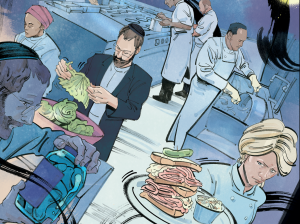The federal government recently released a brand new edition of Canada’s Food Guide, as part of its Healthy Eating Strategy. It is a reflection of the best scientific evidence at this time.
This new guide is different from previous editions, not because scientists changed their minds about what healthy eating entails, but because our knowledge of the subject has evolved over time.
The goal of the food guide is to improve health, help Canadians meet their nutritional needs and, very importantly, reduce the risk of nutrition-related diseases.
This guide establishes four categories of food that make up a balanced diet. Think of a plate and divide it into four sections. Two of those sections should contain plenty of fruits and vegetables that vary in colour – eat a rainbow, so to speak. One quarter of the plate should be protein. These should be consumed in small servings and contain some plant-based proteins, such as tofu and beans. The final quarter of the plate is for whole grain foods, such as multi-grain noodles or brown rice. And the drink of choice? Water. No drinks that are high in sugar. (Milk is considered a protein and no longer a category on its own.)
Yes, there is some disagreement about some of these new guidelines. However, a guideline is not a law, but rather an educated suggestion that needs to be interpreted by each individual.
The guide goes further, though – it does more than just identify healthy foods. We are encouraged to be mindful when we eat, to pay attention and decrease the number of times we eat when we’re rushed, busy, distracted or on the run. Cook more often. Decrease or eliminate foods that are high in sodium or sugar and those containing saturated fats. Home-cooked meals tend to be healthier, as you have control of the ingredients. Enjoy your food. And, very importantly, eat meals with others. This improves our social connectedness and allows us to teach each other good habits.
READ: HEALTHY AGING: HOW TO LOSE WEIGHT – AND KEEP IT OFF
Brazil’s food guide, which was announced in 2015, emphasizes the culture and climate of eating, not simply which foods to choose. Eating is tied to social activities, family and friends. By preparing meals at home, we keep our cultural practices alive. We also share those traditions with our children and grandchildren, exposing them to valuable lessons about family, nutrition and general wellness.
We need to turn off the TV during dinner, remove the devices from the table, close the iPads that were keeping the kids entertained but at a distance and truly engage with each other.
Canada’s Food Guide is a great start. We need to make it our own, use the information as a stepping stone and help reduce the prevalence of eating disorders.
When we look at healthy aging, let’s be proactive with respect to food. Enjoy the process, not simply the end result. Share with others, play well with others, dine with others and let’s all learn to make better choices.







